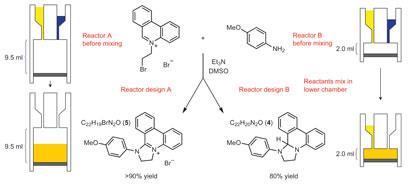Chemists threaten to put glassblowers out of work using a 3D printer to produce dynamic reaction vessels
The time may soon come for chemists to throw away all their old glass reaction vessels. UK and Norwegian scientists have now shown that far better and more effective vessels can be fabricated on a 3D printer.
Not only do 3D printers offer the possibility of producing vessels with much more complex architectures, but the vessels can be designed to influence the course of the reaction or even to take part in it. And if that’s not enough, 3D printers also offer a convenient way to introduce reactant chemicals into the vessels.
’I have always been interested in new ways of doing complex chemistry and exploring new reaction spaces,’ explains lead researcher Lee Cronin at the University of Glasgow. ’I had never used a 3D printer before but met a researcher interested in designing new objects for 3D printed architecture and got to asking them about combining it with chemistry.’

So after building a low-cost 3D printer in his laboratory, following instructions provided by the Fab@Home open-source project, Cronin set about using it to produce a reaction vessel.1 Guided by a computer-generated design, the printer fabricated the vessel using ’ink’ made from a quick-drying silicone polymer usually used as a bathroom sealant to build the vessel up layer by layer. The end result was a plastic vessel comprising two separate solution-holding chambers both leading to a larger mixing and reaction chamber.
Next, Cronin used the printer to introduce different chemical solutions into the two chambers. The two solutions are sucked into the reaction chambers at a controlled rate by poking a needle attached to a vacuum source through the walls of the vessel. Once in the reaction chamber, the chemicals react together, while the hole made by the needle automatically closes up, leaving the vessel water-tight.
Tip of the iceberg
Cronin and his team tried this process with both organic and inorganic chemicals, finding that they were able to produce an organic heterocycle and two inorganic nanoclusters that had never been seen before. By inserting electrodes into the reaction vessel, they were also able to perform electrochemical reactions and even turn the vessel into a working electrochemical cell. But that proved to be just the tip of the iceberg.
Cronin then showed that they could alter the progress of a reaction by simply changing the architecture of the reaction vessel. Using the same basic design, they produced two versions of the vessel with different size reaction chambers: one had a volume of 9.5ml, while the other had a volume of just 2ml.
They then added two different chemical solutions into the solution-holding chambers of each vessel, adding three times more of one solution than the other. The vessel with the large chamber could hold the entirety of both solutions, which thus mixed together in a ratio of three to one, reacting to produce a specific heterocycle. The vessel with the small chamber, on the other hand, could only hold 1ml of each solution, which thus mixed together in an equal ratio, producing a completely different heterocycle (see figure).
Finally, Cronin and his team showed that they could produce reaction vessels that play an active role in a chemical reaction. To do this, they simply added catalytic particles of palladium on carbon (Pd/C) to the polymer ’ink’. Pd/C is very good at catalysing hydrogenation reactions and the reaction vessel fabricated with this Pd/C-containing ink was able to convert styrene into ethylbenzene within around 30 minutes at room temperature.
The potential scope of this novel approach to chemical synthesis is huge, says Cronin, because 3D printing allows you to create reaction vessels with a vast array of different architectures and capabilities. ’This is a fundamentally new way of thinking, blurring the distinction between the reactor and the reaction,’ he tells Chemistry World. ’This is a key aspect because chemists can use CAD (computer-aided design) and reaction design together.’
Daniel Johnson, a chemist at Murray State University in Kentucky, US, certainly thinks the idea will catch on. In an associated News & Views article in Nature Chemistry,2 he says: ’It is likely that 3D printing will be attractive to a range of groups because of the customisation aspect, that is, the inherent control over size, shape and integrated function.’
To this end, Cronin is now busy developing ’apps’ to make it easy for others to print their own reaction vessels. Good news for chemists, but perhaps not such good news for glassblowers.
Jon Evans
References
1 M D Symes et al, 2012, DOI: 10.1038/nchem.1313
2 D Johnson, Nat. Chem., 2012, DOI: 10.1038/nchem.1333






No comments yet